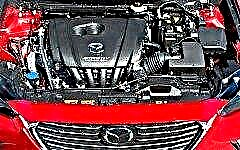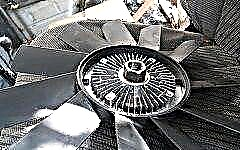

The content of the article:
- General information about viscous coupling
- Principle of operation and purpose
- Varieties of viscous couplings
- Fields of application of viscous coupling
- Cons of viscous coupling
- How to repair a viscous coupling
Any car is a very complex structure, consisting of many units and components. Over time, they start to age and fail to cope with basic tasks, which forces vehicle owners to send a car for repair.
As an example, you can take viscous coupling of the fan, which is intended for selective transmission and directly affects the torque... And in order to prevent possible damage to the unit, as well as to know what actions to take in case of an unforeseen breakdown, you need to carefully study the principle of operation of the viscous coupling, its design features and a number of other points.
General information about viscous coupling

One of the most important components of the car is a rotating viscous coupling, inside of which are alternating perforated plates with a viscous fluid. There are many types of such structures on the market with different working properties and features, but the general principle of their operation remains the same.
Each viscous coupling consists of a plurality of internal plates that are capable of rotating along the drive shaft, as well as external elements connected on the driven shaft at a predetermined interval. All components are interconnected and evenly distributed throughout the body.
Such a part differs from a fluid coupling and a torque converter in a specific operating principle. First of all, another method of torque transmission is involved here, which is based on the action of a special viscous fluid located in the internal space of the structure.
The first mentions of viscous coupling appeared in 1917., but in those days it was not able to become widespread, tk. did not have many of its current advantages. Only in 1964, the product was significantly improved and began to be supplied to the mass market. In the 60s of the last century, these inventions began to appear in cross-wheel differentials on all-wheel drive passenger cars.
Principle of operation and purpose

To understand the principle of operation of a viscous coupling, you must carefully familiarize yourself with its design. All its parts are fixed in one sealed housing, which contains two rows of discs connected by means of a driven and a driving shaft. Each row is equipped with holes and protrusions with a small distance from each other. A highly viscous liquid, consisting of silicone additives, flows inside the viscous coupling. It is characterized by a special composition that makes it possible to efficiently service the drive system and provide the required torque.
One of the unique properties of a liquid is an increase in viscosity with increasing mixing intensity. This value can rise as the system heats up. If the machine is moving at a stable speed, the discs rotate in a uniform manner, and the oil base between them does not mix. But if any difference is noticed between the movement of the shafts, this noticeably affects the intensity of rotation of the working elements. As the viscosity rises, the silicone begins to act on the torque. Ultimately, it will acquire a different state and become practically solid.
Varieties of viscous couplings

On the car parts market, you can find two main types of viscous couplings:
- The first type is characterized by a constant volume of amateurish liquid.
- The second type has a different volume of silicone, which changes depending on external influences.
Viscous couplings of the first type are used for limited slip differentials in the transmission, including automatic all-wheel drive systems. They are used in internal cooling systems.
If the part is working in normal mode with medium loads, and the car is moving on a good road surface, the values of the angular velocities of the two axes remain the same. The rotation of the clutch discs is carried out almost uniformly, and the torque from the engine to the driven axle is transmitted with a minimum load. As a result, the vehicle can operate both on all-wheel drive and on the rear.
But if the car hits rough terrain or drives on ice and mud, the rotation uniformity is severely reduced, and the viscosity of the silicone increases significantly. Thus, there is an increase in the transmission of torque to the second axle. In some cases, the power transfer rate reaches 100 percent.
At the same time, the viscous clutch cannot replace a full-fledged differential, which redistributes the torque of the power plant to both axles. It is advisable to use this design on uneven surfaces and rough terrain. It will also be justified when driving:
- on ice;
- city streets;
- wet track.
If driving on a complete off-road, the clutch should engage instantly. otherwise, the torque transmission system will fail, which will entail the need for expensive and complex repairs.
In most modern machines with "automatic" viscous couplings operate in the so-called "pre-start mode". It is characterized by a uniform transmission of 5-15% of the motor power to the driven axle, which negatively affects the response time of the unit.
Fields of application of viscous coupling

Previously, there were two areas of application for viscous couplings, but today their number has been reduced to one. In the recent past, a similar mechanism was intended for complex engine cooling, which is possible when a special viscous coupling with a ventilation device is attached to the rod. Its movement is determined by the crankshaft of the car, to which the belt is laid. Depending on the speed of rotation of the engine, the fluid acquires a different density and gets a rigid connection with the fan.
With a decrease in revolutions, there was no strong mixing, i.e. if slippage was present, the cooling process of the system was not good enough. It is advisable to use the product as a full-fledged element of the cooling system only in the cold winter season, when the engine is not very hot, it needs to provide additional cooling.
But today, the device is rarely used in cooling equipment, because it was replaced by advanced fans equipped with various sensors. Electronic fans work directly from electrical energy, while they are independent of the crankshaft.
A more demanded area of application is to provide automatic connection of an all-wheel drive system. In this area, viscous couplings are extremely relevant, because most SUVs, crossovers and SUVs are equipped with such units. Even the rapid growth in the popularity of advanced electromechanical options does not spoil the great popularity of viscous couplings.
The product is in great demand due to the following advantages:
- affordable price;
- practical application;
- versatility.
However, in addition to the advantages, viscous couplings also have disadvantages.
Cons of viscous coupling

One of the most significant disadvantages of viscous coupling is its "disposability".In most cases, the part cannot be repaired, and the repair work itself requires a lot of effort and financial investment, so motorists are considering buying a new part.
Also, the disadvantage of the product is the complexity of connecting to the all-wheel drive, because it is difficult to calculate the moment of internal braking of the discs. Achieving complete control of an all-wheel-drive system is nearly impossible.
In addition, manual connection of the drive cannot be performed, and its efficiency is rather low. Maximum torque is only transmitted when braking is strong.
Most models of viscous couplings are small, therefore, when located at the bottom of the system, there is a limitation of the transmission of torque to the rear axle.
Such a device is not able to work for a long time and withstand impressive loads.... Otherwise, it will quickly deform and become unusable. Prolonged driving on off-road, mud or ice will lead to the fact that the viscous coupling will fail and will need to be replaced.
How to repair a viscous coupling

If the engine starts to overheat and makes a lot of noise when operating at high speeds, there is no need to rush to replace the viscous coupling. If you approach such a problem correctly, it can be eliminated with little effort. Often, breakdown occurs when oil leaks from the base of the structure, which requires re-pouring the silicone. To solve the problem, you need to carefully remove the part from the pump, and then disassemble it. On the round disc of the element there must be a plate with a spring, under which there is a hole for the oil base.
To prevent damage to the product, care must be taken when removing the pin. Then you should start adding lubricant, for which it is better to use a syringe. It is important to note that when performing such a task, it is better to place the viscous coupling horizontally. Using a syringe, you can take 15-20 ml of liquid, and slowly put it inside.
After a few minutes, the silicone should penetrate tightly into the viscous coupling and acquire a sufficiently solid state. Ultimately, it is necessary to clean the surface of the structure from excess silicone and re-install the part.
In the absence of skills in performing such a task and ignorance of the general principle of the viscous coupling, it is better to refuse do-it-yourself repairs and entrust the repair to an experienced specialist.
Another common cause of viscous coupling damage is bearing deformation. The first symptom of this type of malfunction is intense noise. To repair the product, it must be dismantled by unscrewing the three fixing bolts. In this case, the structure can be easily detached from the engine compartment. After removing the coupling and draining the silicone, you can begin the procedure for replacing the bearings.
There are no particular difficulties in solving such a problem, but in order to simplify the task, it is recommended to use a special puller. This tool is available in every garage. When using improvised means, you can completely damage the unit and cause yourself additional trouble in the form of expensive repairs. After completing the installation of the new bearing, it remains to reassemble the part and start the engine.
Also, when carrying out repairs, one must not forget about the filling of new silicone, which was drained before the repair. If the clutch “behaves incorrectly”, there is no need to rush to buy a new product, because, perhaps, the problem lies in a minor breakdown, which can be quickly solved with our own hands. And for this it is not necessary to have special skills and abilities.
The only problem during repairs is the difficulty of finding a tool to remove an old bearing. If it is not in the garage, you can borrow it from friends or purchase it from a car repair shop. Other parts and consumables are available in all automotive stores.
It is also important to note that not all viscous couplings are equipped with a liquid filling hole. If you do not have experience in repairing such structures, it is better not to rush into taking action and entrust the task of replacing or repairing a viscous coupling to a trained specialist.
It is also important to avoid the use of brute physical force, because the clutch disc is vulnerable to intense influences and can fail at the slightest load. In this case, the consequences will be irreversible and you will have to completely change the device.
Conclusion
Basically, it is not difficult even for a novice motorist to understand the principle of operation of a viscous coupling. The same goes for repairs and maintenance of parts that do not require specific skills or professional experience. It is enough to follow simple instructions and take into account the recommendations of specialists.











